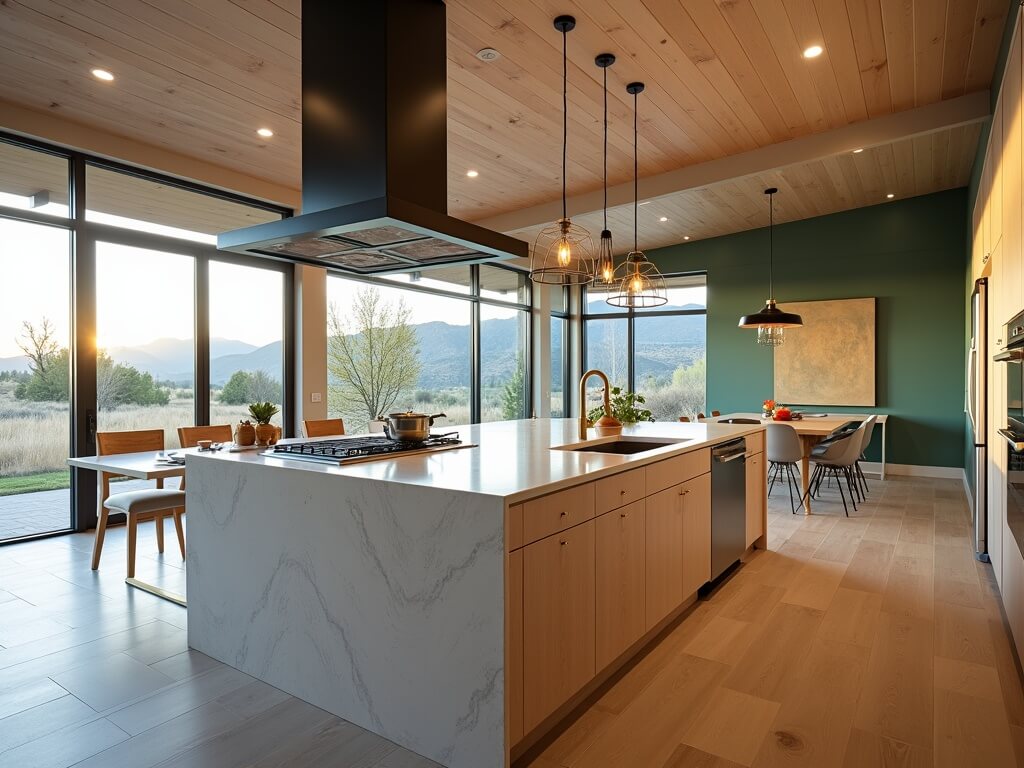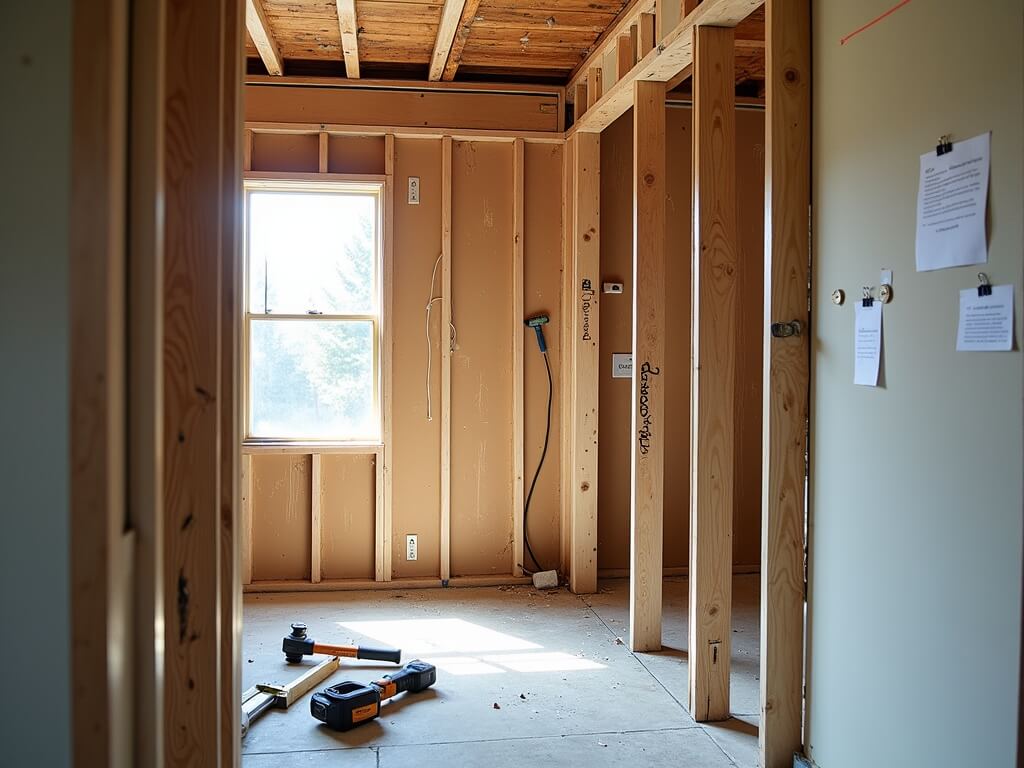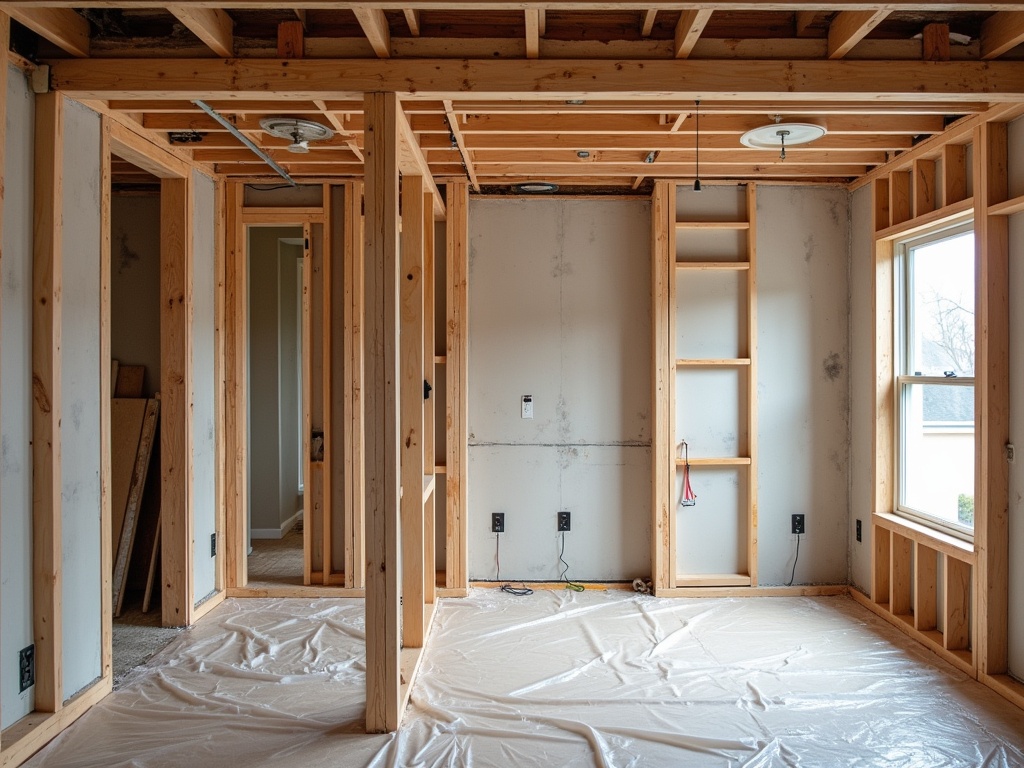Expert Tips from a Kitchen Remodel Contractor: Achieving Open-Concept Layouts Safely and Efficiently
Discover the insider secrets to successful open-concept kitchen remodels in Bend, Oregon, straight from a seasoned contractor—learn how professional design, local expertise, and structural know-how can transform your space while avoiding costly mistakes and delivering a stress-free, high-impact renovation.

Thinking of hiring a kitchen remodel contractor in Bend to knock down that wall for an open-concept layout?
You're not alone.
Most people come to me asking the same handful of questions:
- What’s it really like to open up our kitchen?
- Will removing a wall mess up the structure?
- Can we get it all done within budget… without hating the process?
I’ve helped dozens of families across Bend turn chopped-up kitchens into modern, airy, energy-efficient hangout spots that actually work for daily life. Here’s exactly what I tell friends and clients over coffee—no fluff, no contractor-speak.

What a Kitchen Remodel Contractor Actually Does (and Why It Matters)
If you’re thinking remodeling is just “demo, install cabinets, done”—you’re missing what separates a DIY disaster from a dream remodel.
A top-tier kitchen remodel contractor handles the entire process from design ideas to permits to construction. In Bend, that includes knowing how our Central Oregon climate affects materials and dealing with strict city permitting rules.
But even more important? Project management.
I’ve seen homeowners try to DIY part of a kitchen job and end up overwhelmed halfway through. Orders delayed, subcontractors ghosting them, uncertainty about codes—this stuff adds up.
Your contractor owns the timeline, budget, quality of finished work, and coordination of every moving piece, including:
- Permits (especially for structural changes)
- Electricians, plumbers, carpenters
- Ordering and storing the right materials in the right sequence
- On-site inspections and walkthroughs
If all that sounds overwhelming—it is, unless you’ve done it a dozen times.
Hiring a pro contractor in Bend means the hard stuff gets handled, and you just get to enjoy the end result.
Quick takeaway: Your contractor isn’t just installing cabinets—they’re steering the entire ship.
How the 5-Step Remodel Process Works (And Where It Could Go Wrong)
This is the checklist I personally walk clients through every time we take on a kitchen.
1. Initial Consultation + Design
We sit down, show pictures, talk through how the space is (or isn’t) working. Do they cook every night? Work from home at the island? Need kid-proof everything?
From that chat, a design plan and budget range come together fast. 90% of remodel stress comes from unrealistic expectations—this first step eliminates that.
2. Planning + Permits
Once the draft design is dialed, we submit for permits. If structural walls are coming down, this is critical. The city of Bend requires sign-off when load-bearing walls are altered.
3. Budget Confirmation + Timelines
We present a firm estimate broken into categories: demo, materials, electrical, etc. No vague "ballpark" nonsense—actual numbers homeowners can approve or tweak.
Timelines also get mapped out: most full kitchen remodels land between 6–12 weeks.
4. Construction Phase
Now we’re in work boots. Materials are ordered. Walls come down (with or without temporary supports depending on the engineering). Floors, plumbing, cabinetry, electrical—fully managed, fully transparent.
I visit each jobsite regularly and send photo updates so homeowners know what’s happening, even on vacation.
5. Final Walkthrough
We do not "wrap and run" once the paint dries.
We walk through the finished kitchen, check every outlet, door, drawer, faucet—and don’t close the project until it’s right. Every contractor should stand behind their work with a warranty or satisfaction guarantee.
Pro Tip: Ask your contractor how they handle issues discovered during demo. That’s where amateurs panic, but pros have contingency playbooks.

Why Hiring a Professional Is the Best Money You’ll Spend
You can buy the prettiest tile or the best appliances—but if your remodel is mismanaged, none of that matters.
Here’s why I always advocate hiring a local kitchen remodel contractor (not your cousin’s handyman from out of town):
- They understand Central Oregon’s unique building codes, permitting process, and weather impacts on material choices
- They know which walls are structural—and what to do safely if they must go
- They’ve got a vetted team of electricians, plumbers, designers, inspectors, and trades ready to go
- They can spot problems before they become disasters (think mold behind cabinets or degraded subfloors)
I once helped a couple remodel their forever-home kitchen and discovered—during demo—that the previous owner had cut into a load-bearing wall to install open shelves.
No permit. No inspection. No reinforcement.
It could’ve collapsed—seriously.
We brought in an engineer, reinforced it with a steel beam, and saved the open-concept design without compromising safety. That’s the hidden value of hiring someone who’s done this more than just once.
What to Ask Before You Hire Any Contractor in Bend
Want to separate the pros from the posers?
Ask these questions up front:
- Who completes the permitting and will I see copies?
- What wasn’t included in this estimate—and what could come up?
- If you find mold, outdated wiring, or a structural surprise, what happens next?
- How many hours per day is your crew on-site?
- Will it be the same crew every day or rotating subs?
- Can I see three other kitchens like mine you finished recently?
Don’t just get references—ask to visit a finished project locally in Bend. Nothing builds trust like seeing your future kitchen in someone else’s home.
Quick takeaway: Be picky about who you hire. The right contractor won’t shy away from tough questions—and will answer with process, not just promises.
Why Open-Concept Kitchens Are the Star of Modern Renovations
Let’s talk about design—specifically, open-concept kitchen layouts.
If your current kitchen feels cramped, cut off from the rest of the house, and like you’re missing the party while you’re cooking—open-concept is a game-changer.
You knock out the walls and suddenly, it’s one seamless space shared by kitchen, dining, and living.
More light. More connection. Way more function.
Here’s why Bend homeowners are obsessed with this style:
- It makes small homes feel twice the size
- You can entertain while cooking (without shouting from behind a wall)
- Kids can do homework at the island while dinner simmers
- Clean sightlines make supervision easier while multitasking
- Guests naturally gather in the kitchen, so the flow feels social and inviting
How I Learned This Firsthand:
Years ago, I remodeled my own 1990s split-level with one of those boxed-in kitchens. Spending holidays cooking alone while everyone else laughs in the living room was not an option.
We took down two walls and put in a 10-foot island. It transformed hosting events—and everyday life. Now our kids snack at the island after school while we prep dinner. Best construction decision I’ve ever made.
That taught me: knock down the right wall, and your whole house evolves overnight.
Designing a Smart Open Kitchen (Not Just a Pretty One)
A lot of folks think an open layout is just about knocking stuff down. But smart design makes or breaks how it functions.
Here’s what we plan for every single job:
1. Define Zones
Even with an open floor plan, you need a cooking zone, a dining zone, and a lounge/entertaining zone.
Use furniture, lighting, rugs, and layout to give each area purpose without walls.
2. Add a Focal Point
Without visual structure, big open spaces can feel...weirdly empty.
We add:
- Oversized range hoods
- Tile backsplashes that stretch to the ceiling
- Waterfall-edge islands
- Vent hoods that actually work
Let your kitchen anchor the space, not fade into it.
3. Merge Dining Into Design
Don’t force people to shuffle between rooms.
Use:
- Bar-seating islands for casual breakfasts
- Drop-down counters that feel like traditional dining tables
- Built-in banquettes (huge space saver and design win)
In Bend, we’re seeing this blend of function and form in almost every remodel—and clients love it.
Top Kitchen Design Trends in Bend Right Now
Here’s what’s hot in Central Oregon kitchens:
- White oak cabinetry over stark-painted styles
- Quartz countertops for beauty and durability
- Waterfall islands for a modern edge
- Mixed metals (think matte black plus brushed gold)
- Earthy neutral colors—sage green, warm taupe, terracotta
- Open shelving that shows off pottery or ceramics from local Bend artists
- Energy-efficient appliances (hello lower power bills)
- Low-maintenance finishes for busy homes
In short: style meets practicality. And in Bend, where we prize outdoor living, we want surfaces and layouts that suit messy families and laid-back entertaining.
Keep reading—we’ll get into structural safety next, including exactly how to know if that wall you want to remove is load-bearing… or load-bearing trouble.
How to Know If That Wall’s Safe to Remove (and What Happens If It’s Not)
Here’s the truth every open-concept dreamer has to face: not every wall wants to come down.
Some hold up your house. And if you don’t know which is which before swinging the hammer—you’re gambling with drywall, structure, and safety.
This is one of the most misunderstood parts of remodeling in Bend. And I get it—when there’s a wall smack in the middle of your kitchen and living room, it feels like the enemy.
But here’s what I tell every client before we start drawing demo lines:
Not all walls are created equal.
You’ve got:
- Load-bearing walls – the structural backbone, holding up everything above
- Partition walls – just drywall and studs dividing space
Spotting the difference isn’t always obvious. Some partition walls look beefy. Some structural walls look thin.
That’s why I always start with these checks:
1. Check the joist direction in the attic or crawl space.
If the joists run perpendicular to the wall, that’s a flag it might be load-bearing.

2. Look for beams or posts underneath.
If there’s a wall directly above a steel or wood beam in the crawl space or basement—you’re likely dealing with structural.
3. Review old blueprints (if you’ve got them).
Walls labeled with “S” or those under main roof ridges typically take on load.
4. Use your local contractor’s brain.
Seriously—contractors who’ve remodeled homes in your exact Bend neighborhood can often spot common structural layouts before a single wall is opened.
When in doubt, we call in a structural engineer before doing anything.
Pro Tip: Even when removing a wall turns out safe, we still need to submit plans and pull permits in Bend. The city isn’t messing around with structural safety (and neither are we).
What If It Is Load-Bearing? You Still Have Options
Let’s say your wall is structural—but you still want that open kitchen.
Here’s the battle-tested plan we use when opening up a load-bearing section:
- Bring in a structural engineer to define the right beam size
- Pull permits and submit framing revisions to the city
- Build temporary support walls
- Carefully demo the existing wall
- Install engineered beams (I-beams or LVLs, depending on finish and weight)
- Patch back with drywall and finishes like the wall was never there

Bonus: I often use this moment to majorly upgrade the electrical and plumbing behind the wall—we’re already open, so making those systems future-proof is smart money.
That entire scope can take a few extra days... but opens your whole home for the next 20+ years.
True Story: A couple in Northwest Crossing wanted to connect kitchen and family room over the holidays. I told them their center wall was structural. They almost scrapped the project.
We brought in an engineer, mapped out a steel flush beam, and four weeks later, they hosted New Year’s with a stunning eat-in island and full view of their fireplace.
They still email me every Christmas.
Key takeaway: Structural wall? Not a deal-breaker—just a reason to hire the right team.
The Safe Way to Remove a Wall (Your Uncle’s Opinion Doesn’t Count)
Here’s the wrong way to remove a structural wall:
- Hit it with a sledgehammer.
- Add a “header” board you found on YouTube.
- Hope it holds.
Don’t be that guy.
Here’s the right way, which we use on every project—because we like your house standing upright:
1. Temporary Support First
We build temporary walls to hold the floor or ceiling above before a single 2x4 is disturbed.
2. Engineered Beam Installation
We use engineered LVL (laminated veneer lumber) or steel beams calculated by a pro. No eyeballing. If we need to span more than 6-10 feet, I always go engineered.
3. Load Transfer to New Posts
Loads go from the beam into posts and down to the foundation. That’s the complete load path—and without it, you're just guessing.
4. Final Inspection
We call for city inspection and signoff before closing up drywall.
I once inherited a client midway through a DIY wall removal. No permits. Hand-notched 4x4 post. The ceiling was already sagging.
We had to reinforce the beam, slice into subfloor to run a post to foundation, and patch a cracked ceiling. That’s what shortcuts cost.
Don’t Guess. Get a Game Plan.
If you’re even considering wall removal in a remodel: ask your contractor how they handle structural engineering, permitting, and beam sizing.
If they get weirdly vague or say “it’s probably not load-bearing”—walk.
Work with a crew who can pull permits, bring in pros, and make sure your home is safer after remodel, not riskier.
Your home insurance—and your family—will thank you.
Key takeaway: Removing walls safely takes planning, permits, and professionals, not a Pinterest board.
How We Tie It All Together with DCR Northwest
By now you might be thinking: this is a lot to manage.
Good news? You don’t have to do it alone.
I run DCR Northwest as a full-service design-build team right here in Bend.
That means we handle everything in-house from drawings to demo to that final celebration dinner—and yes, we also do full house remodels, ADUs, DADUs, and bathroom transformations when the kitchen needs company.
Why that matters:
- Fewer handoffs, fewer surprises
- We know the flow from concept to city approval to finish detail
- Our team communicates every step so you’re never “in the dark”
Our process is built specifically for homeowners in Bend who want one point of contact, one team of pros, and zero guesswork.
Want open-concept that actually feels tailored to your lifestyle?
It starts with clarity on what works—for you, your structure, and your budget.
Let’s make your kitchen the heart of your home again.
Quick Recap Before You Call the Contractor
- Not every wall can come down—but every wall can be evaluated
- Load-bearing solutions exist. Flush beams can open up any space safely
- Open-concept kitchens are about smart layout, not just demolishing walls
- A good contractor drives the timeline, communicates throughout, and owns the result
- In Bend, hire folks who work here full-time—building in Central Oregon isn’t like anywhere else
Every great remodel begins with the right questions.
And it ends with a kitchen where family, function, and form all flow together.
Looking for a trusted kitchen remodel contractor in Bend who’s done this before?
Call 541-699-2502 or email matt@dcrnorthwest.com and let's talk about making your space work—for real life.
Let's build something you’ll love to come home to.
Your kitchen remodel contractor shouldn’t just wear a tool belt—they should bring a vision, too.
Explore related resources for safe wall removal:


